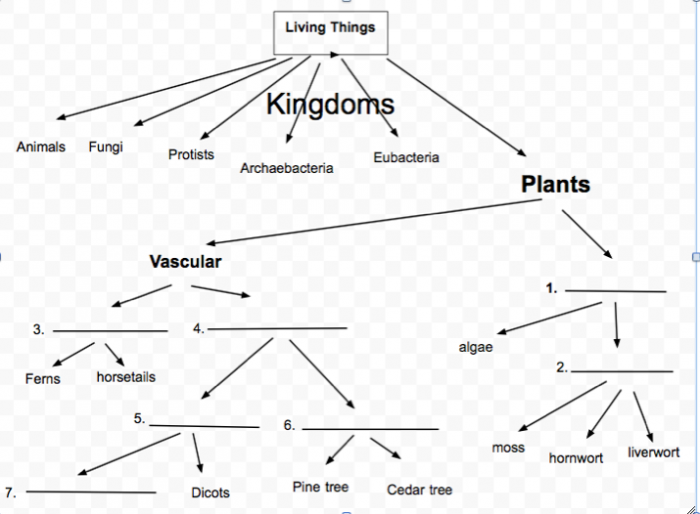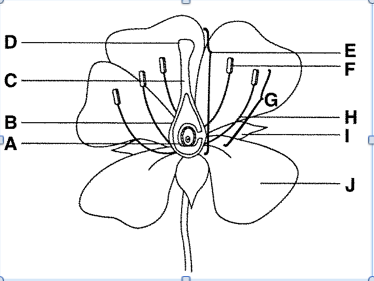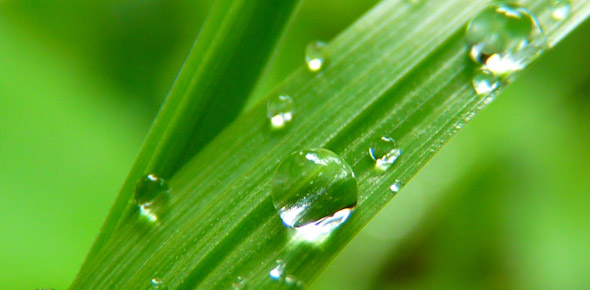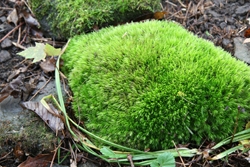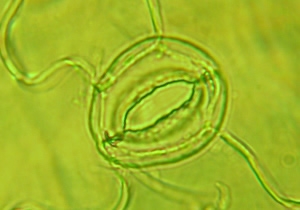Plant Parts, Functions And Adaptations
-
Vascular plants transport water through structures called
-
Xylem
-
Phloem
-
Cotyledons
-
Stolon
-
Explore the diverse structures and functions of plants, including adaptations, types of roots, and the role of guard cells in stomata regulation.

Quiz Preview
- 2.
# 3 is ___________
Explanation
The given correct answer for this question is "non-seed plant" or "Non-seed plant." This suggests that option 3, which is not mentioned in the question, is referring to a type of plant that does not reproduce through seeds. This could include plants that reproduce through spores or other methods, such as ferns or mosses.Rate this question:
- 3.
C ________
Explanation
The question is asking for a word that fits in the blank space provided. The word "style" is a suitable answer as it completes the sentence and fits grammatically. The word "style" can be used to describe a particular manner or way of doing something, such as a fashion style or a writing style.Rate this question:
- 4.
D ___________
Explanation
The correct answer is "stigma, Stigma." This suggests that the missing letter in the word is "S", as it is capitalized in the second option. The word "stigma" refers to a mark of disgrace or shame associated with a particular circumstance, quality, or person. The repetition of the word in both lowercase and uppercase reinforces the idea that "stigma" is the correct answer.Rate this question:
- 5.
E _______________
Explanation
The given answer is "pistil, Pistil". The word "pistil" is repeated twice, once in lowercase and once in uppercase. This repetition suggests that "pistil" is the correct answer. The term "pistil" refers to the female reproductive organ of a flower, which is responsible for producing seeds. Therefore, it is a suitable response to the given question.Rate this question:
- 6.
F _________
Explanation
The given answer "anther, Anther" is correct because it fills in the blank space and matches the capitalization of the word "Anther" in the second line. The word "anther" is repeated in the first line, indicating that the answer should be a repetition of the same word with the same capitalization.Rate this question:
- 7.
G __________
Explanation
The question is asking for a word that starts with "G" and is followed by "stamen" and "Stamen". The correct answer is "G stamen" and "G Stamen".Rate this question:
- 8.
H ___________
- 9.
I ____________
- 10.
J ____________
- 11.
Native plants are important to an ecosystem because they
-
Are best adapted to the environment in which they evolved
-
Are best suited to share an ecosystem with other plants and animals that evolved with them
-
Help to ensure the health and well being of other plants and animals that have come to depend on them for survival
-
All of these
Correct Answer
A. All of theseExplanation
Native plants are important to an ecosystem because they are best adapted to the environment in which they evolved. This means that they have developed specific traits and characteristics that allow them to thrive in their particular habitat. Additionally, native plants are best suited to share an ecosystem with other plants and animals that evolved with them. They have established complex relationships and dependencies with other species, such as pollinators and herbivores. By providing food, shelter, and other resources, native plants help to ensure the health and well-being of other plants and animals that have come to depend on them for survival. Therefore, all of these reasons make native plants crucial for maintaining a balanced and functioning ecosystem.Rate this question:
-
- 12.
Select from the following terms to complete the dichotomous key or mind map: vascular, non-vascular, seed plant, non-seed plant, bryophyte, gymnosperm, angiosperm, pollen, monocot, dicot, horsetails, xylem, phloem#1 is ___________
Correct Answer
non-vascular
Non-vascularExplanation
The correct answer is "non-vascular." Non-vascular plants, also known as bryophytes, do not have specialized tissues for transporting water and nutrients throughout their bodies. They lack xylem and phloem, which are responsible for conducting water and nutrients in vascular plants. Examples of non-vascular plants include mosses, liverworts, and hornworts.Rate this question:
- 13.
# 2 is _______________
Correct Answer
bryophyte
BryophyteExplanation
The correct answer for this question is "bryophyte" or "Bryophyte". The term "bryophyte" refers to a group of non-vascular plants that includes mosses, liverworts, and hornworts. These plants lack true roots, stems, and leaves, and they reproduce through spores. The term "Bryophyte" is capitalized to indicate the scientific classification of this group of plants.Rate this question:
- 14.
# 4 is ___________
Correct Answer
seed plant
Seed plantExplanation
The given correct answer is "seed plant" or "Seed plant". This suggests that the missing word or term in the blank is "seed plant". A seed plant is a type of plant that reproduces through seeds, which are enclosed in a protective structure. This is in contrast to plants like ferns or mosses, which reproduce through spores. The repetition of the answer in both lowercase and uppercase letters indicates that it is the correct and complete answer to the question.Rate this question:
- 15.
#5 is _______
Correct Answer
angiosperm
AngiospermExplanation
The correct answer for this question is "angiosperm" or "Angiosperm." The term "angiosperm" refers to a group of plants that produce flowers and have enclosed seeds. It is a type of plant that is characterized by its reproductive structures, such as the flowers and fruits. The term "Angiosperm" is simply the capitalized version of "angiosperm." Both terms refer to the same group of plants, and either answer would be correct in this context.Rate this question:
- 16.
# 6 is ___________
Correct Answer
gymnosperm
GymnospermExplanation
The correct answer for this question is "gymnosperm" and "Gymnosperm". Gymnosperms are a group of plants that produce seeds that are not enclosed in a fruit. They include conifers, cycads, and ginkgoes. The answer options provided are variations of the same word, with one capitalized and one not. Both options are correct and refer to the same group of plants.Rate this question:
- 17.
B ___________
Correct Answer
ovary
OvaryExplanation
The given answer is "ovary, Ovary". This suggests that the letter "B" is missing from the word "ovary" and needs to be filled in. The correct spelling of the word is "ovary" and it refers to the female reproductive organ in animals, including humans, where eggs are produced. The capitalization of the second "O" in "Ovary" indicates that it should be written with a capital letter.Rate this question:
- 18.
# 7 is ________
Correct Answer
monocot
MonocotExplanation
The correct answer is "monocot" or "Monocot". This suggests that the missing word or phrase in the question is likely asking for a specific type or category. In this case, "monocot" refers to a type of flowering plant that has a single cotyledon or seed leaf. It is a term used in botany to classify plants based on their characteristics, such as the number of cotyledons.Rate this question:
- 19.
Using the list below, select the best term to label the flower.petal, sepal, nepal, stamen, pistil, ovary, ovule, peduncle, receptacle, anther, style, stigma, filament, cotyledon, hypocotylA. _________
Correct Answer
ovule
Ovule - 20.
Do all plants have flowers?
-
Yes, flowers are the reproductive organ for all plants, so all plants must have them to continue their species.
-
No, flowers are the reproductive organs for angiosperms.
-
No, only nonvascular plants have flowers.
-
No, only plants producing spores create flowers.
Correct Answer
A. No, flowers are the reproductive organs for angiosperms.Explanation
The correct answer is "No, flowers are the reproductive organs for angiosperms." This answer is correct because not all plants have flowers. Flowers are the reproductive organs specifically for angiosperms, which are a group of plants that produce seeds enclosed in a protective structure (fruit). Other groups of plants, such as gymnosperms, do not have flowers but instead have different reproductive structures like cones. Therefore, it is incorrect to say that all plants have flowers.Rate this question:
-
- 21.
Guard cells
-
Help protect flowers from pollen robbing insects
-
Are an adaptation that helps bryophytes produce spores for reproduction
-
Help to regulate water loss by controlling the size of the stomata in leaves
-
None of these
Correct Answer
A. Help to regulate water loss by controlling the size of the stomata in leavesExplanation
Guard cells help to regulate water loss by controlling the size of the stomata in leaves. Stomata are small openings in the surface of leaves that allow for gas exchange, but they can also lead to excessive water loss through transpiration. Guard cells surround the stomata and can change shape to open or close the stomatal pore. By opening the stomata, guard cells allow for the exchange of gases such as carbon dioxide and oxygen, but also increase water loss. By closing the stomata, guard cells reduce water loss, helping to regulate the plant's water balance.Rate this question:
-
- 22.
Fibrous roots
-
Can help to control erosion.
-
Are used by plants to store large quantities of food.
-
Reproduce by spores.
-
Contain many stoma to help absorb water.
Correct Answer
A. Can help to control erosion.Explanation
Fibrous roots can help to control erosion because they form a dense network of roots that spread out in all directions, effectively holding the soil together. This prevents soil erosion by reducing the impact of wind and water on the soil surface. Additionally, the fibrous roots also absorb water from the soil, further stabilizing the soil and preventing erosion.Rate this question:
-
- 23.
This is a typical leaf from a
-
Bryophyte
-
Nonvascular plant
-
Monocot
-
Dicot
Correct Answer
A. MonocotExplanation
The given leaf is a typical example of a monocot plant. Monocots are characterized by having leaves with parallel veins, while dicots have leaves with branching veins. Bryophytes are nonvascular plants, which means they do not have specialized tissues for transporting water and nutrients. Therefore, the leaf cannot be from a bryophyte.Rate this question:
-
- 24.
Which of the following are adapted to help a plant propagate (create a new plant)?
-
Stolon and thorns
-
Adventitious roots and stolon
-
Thorns and spores
-
Root hairs and tap roots
Correct Answer
A. Adventitious roots and stolonExplanation
Adventitious roots and stolons are adapted to help a plant propagate. Adventitious roots are roots that form from any part of the plant other than the primary root, and they can help the plant establish new individuals by taking root in the soil. Stolons, also known as runners, are horizontal stems that grow along the ground and produce new plants at nodes, allowing for vegetative reproduction. Therefore, both adventitious roots and stolons are mechanisms that plants use to create new plants and ensure their propagation.Rate this question:
-
- 25.
All plants that reproduce with seeds are
-
Vascular plants
-
Bryophytes
-
Nonvascular plants
-
Dicots
Correct Answer
A. Vascular plantsExplanation
Vascular plants are the correct answer because they are the only group of plants that reproduce with seeds. Vascular plants have specialized tissues called xylem and phloem that transport water, nutrients, and sugars throughout the plant. This allows them to grow larger and more complex compared to nonvascular plants like bryophytes, which lack these tissues and are generally smaller in size. Dicots, on the other hand, are a type of flowering plant that have two seed leaves, but not all plants that reproduce with seeds are dicots. Therefore, the correct answer is vascular plants.Rate this question:
-
- 26.
Which of the following is NOT true about plants?
-
Their cells have cell walls.
-
All plants are dependent upon animals (insects are included!) to spread pollen to other plants of their species to reproduce successfully.
-
Plants produce their own food energy through photosynthesis.
-
Sexual reproduction is important to a plant to increase its diversity and to increase its chances of adapting to changes in the environment.
Correct Answer
A. All plants are dependent upon animals (insects are included!) to spread pollen to other plants of their species to reproduce successfully. -
- 27.
Looking at this moss, check all of the terms below that best describe what you know about it.
-
Plant
-
Animal
-
Fungus
-
Vascular
-
Nonvascular
-
Bryophyte
-
Seed plant
-
Seedless plant
-
Reproduces by spores
-
Angiosperm
-
Gymnosperm
-
Monocot
-
Dicot
Correct Answer(s)
A. Plant
A. Nonvascular
A. Bryophyte
A. Seedless plant
A. Reproduces by sporesExplanation
The moss described in the question is a plant because it belongs to the plant kingdom. It is nonvascular, meaning it lacks specialized tissues for transporting water and nutrients. It is a bryophyte, which is a group of nonvascular plants that includes mosses. It is also a seedless plant because it does not reproduce through seeds but rather through spores.Rate this question:
-
- 28.
Gymnosperms
-
Are seed plants
-
Contain "naked seeds" in cones rather than enclosed in a "fruit"
-
Are usually wind pollinated
-
All of these
Correct Answer
A. All of theseExplanation
Gymnosperms are a group of plants that have naked seeds, meaning their seeds are not enclosed in a fruit. They reproduce through wind pollination, which means their pollen is carried by the wind to reach the female cones. Therefore, the correct answer is that gymnosperms exhibit all of these characteristics: they are seed plants, have naked seeds in cones, and are usually wind pollinated.Rate this question:
-
- 29.
This is a picture of
-
A stoma
-
A xylem
-
A phloem
-
A spore
Correct Answer
A. A stomaExplanation
The correct answer is a stoma. A stoma is a small opening found on the surface of leaves and stems of plants. It is surrounded by specialized cells called guard cells, which regulate the opening and closing of the stoma. Stomata play a crucial role in the exchange of gases, allowing carbon dioxide to enter the plant for photosynthesis and releasing oxygen and water vapor. They also help in the regulation of water loss through transpiration.Rate this question:
-
- 30.
Why did the stomata from our geranium plant close when we placed them in salt water?
-
Water entered the cells of the leaf and the guard cells became rigid.
-
Water left the cells of the leaf and the guard cells became limp and closed helping the leaf to conserve water
-
Equilibrium was reached
-
There was no concentration gradient
Correct Answer
A. Water left the cells of the leaf and the guard cells became limp and closed helping the leaf to conserve waterExplanation
When the geranium plant was placed in salt water, the concentration of salt outside the cells was higher than inside the cells. This caused water to move out of the cells through osmosis, resulting in the cells losing water and becoming limp. The guard cells, which control the opening and closing of stomata, also lost water and became limp, causing them to close. This closure helps the leaf to conserve water by reducing the loss of water vapor through transpiration.Rate this question:
-
- 31.
Looking at this picture, check each term below that can be used to describe the type of plant.
-
Plant
-
Non vascular
-
Vascular
-
Seed plant
-
Non seed plant
-
Angiosperm
-
Monocot
-
Dicot
Correct Answer(s)
A. Plant
A. Vascular
A. Seed plant
A. Angiosperm
A. DicotExplanation
The given picture shows a plant, which is a living organism that belongs to the kingdom Plantae. It also exhibits vascular tissue, which is responsible for the transport of water, nutrients, and sugars throughout the plant. The presence of seeds indicates that it is a seed plant, as seeds are reproductive structures that allow for the dispersal and germination of offspring. Additionally, the presence of flowers suggests that it is an angiosperm, which is a type of seed plant that produces flowers and fruits. Lastly, the presence of two cotyledons in the seedling indicates that it is a dicot, which is a type of angiosperm that typically has two embryonic leaves.Rate this question:
-
- 32.
A complete flower
-
Contains a pistil, but no stamen
-
Has both petals and sepals
-
Contains both a pistil and stamen
-
Has all four organs that we studied: flower, leaves, stems and roots
Correct Answer
A. Contains both a pistil and stamenExplanation
A complete flower is one that contains both a pistil and stamen. The pistil is the female reproductive organ, consisting of the stigma, style, and ovary, while the stamen is the male reproductive organ, consisting of the anther and filament. The presence of both of these organs indicates that the flower is capable of both producing and receiving pollen, allowing for sexual reproduction.Rate this question:
-
- 33.
Check as many terms from the list below that are more common among dicots than monocots.
-
Flowers, roots, stems and leaves
-
Flowers with petals in multiples of 3
-
Flowers with petals in multiples of 4 or 5
-
Fibrous roots
-
Tap roots
-
Woody stems
-
Seeds with 1 cotyledon
-
Seeds with 2 cotyledons
-
Leaves with branching veins
-
Leaves with parallel veins
Correct Answer(s)
A. Flowers with petals in multiples of 4 or 5
A. Tap roots
A. Woody stems
A. Seeds with 2 cotyledons
A. Leaves with branching veinsExplanation
Dicots are characterized by having flowers with petals in multiples of 4 or 5, tap roots, woody stems, seeds with 2 cotyledons, and leaves with branching veins. These characteristics are more common among dicots than monocots. Monocots, on the other hand, typically have flowers with petals in multiples of 3, fibrous roots, herbaceous stems, seeds with 1 cotyledon, and leaves with parallel veins.Rate this question:
-
- 34.
Bryophytes
-
Cannot grow more than a few centimeters in height because they cannot transport water up and down their stems
-
Have only one cotyledon
-
Are called gymnosperms
-
All of these
Correct Answer
A. Cannot grow more than a few centimeters in height because they cannot transport water up and down their stemsExplanation
Bryophytes cannot grow more than a few centimeters in height because they cannot transport water up and down their stems. This is because bryophytes lack specialized tissues for water transport, such as xylem and phloem. Without these tissues, water uptake and distribution within the plant is limited, resulting in a small size.Rate this question:
-
- 35.
A stamen of a typical flower consists of
-
Anthers and a pistil
-
Stigmas and a style
-
An anther and a filament
-
A carpel and a pistil
Correct Answer
A. An anther and a filamentExplanation
The stamen of a typical flower consists of an anther and a filament. The anther is the part of the stamen that produces and releases pollen, while the filament is the stalk that supports the anther. Together, the anther and filament make up the male reproductive organ of the flower. The other options in the question, such as anthers and a pistil or stigmas and a style, are incorrect as they do not represent the components of a stamen.Rate this question:
-
Quiz Review Timeline (Updated): Mar 15, 2023 +
Our quizzes are rigorously reviewed, monitored and continuously updated by our expert board to maintain accuracy, relevance, and timeliness.
-
Current Version
-
Mar 15, 2023Quiz Edited by
ProProfs Editorial Team -
Apr 19, 2015Quiz Created by
Bkanoy
BIO 102 Quiz #4
Plants are a very important part of human survival on earth and if they didn’t exist it is unsure whether man would. Plants are responsible for the oxygen we breathe and...
Questions:
25 |
Attempts:
354 |
Last updated:
Mar 21, 2023
|
Science Benchmark Test - 2nd Quarter - 5th Grade
This 5th Grade Science Benchmark Test for the 2nd Quarter assesses key concepts in biology and botany, including cell energy, tissue functions, and plant adaptations to...
Questions:
23 |
Attempts:
545 |
Last updated:
Mar 22, 2023
|
Final Exam Bio 111
This quiz assesses knowledge on plant adaptations, life cycles, and reproductive mechanisms in various plant groups, focusing on botanical concepts.
Questions:
30 |
Attempts:
1104 |
Last updated:
Mar 22, 2023
|
Celebrate Nature: How Much Do You Know About Apple Tree Day?
Join the celebration of nature's bounty with our Apple Tree Day quiz! Test your knowledge on the fascinating world of apple trees, from their historical significance to the...
Questions:
15 |
Attempts:
19 |
Last updated:
Dec 19, 2023
|
How Well Do You Know Leafly Cannabis Strains?
Ready to put your cannabis knowledge to the test? Our 'How Well Do You Know Leafly Cannabis Strains?' quiz is your chance to prove your expertise. Dive into the world of...
Questions:
10 |
Attempts:
164 |
Last updated:
Nov 25, 2024
|
Carl Linnaeus Quiz: Are You A True Carl Linnaeus Fan?
Embark on a botanical adventure with our Carl Linnaeus Quiz! Delve into the world of taxonomy and challenge your knowledge about the legendary naturalist. Explore his life,...
Questions:
15 |
Attempts:
220 |
Last updated:
Oct 14, 2023
|
 Back to top
Back to top



